Assam: Gateway to North East india
Assam is a land of scenic beauty, which yet has unexplored mountain ranges, evergreen forests, rare wildlife, a mesh of rivers dominated by the Brahmaputra and Barak, expansive tea gardens, oilfields, varied fairs and festivals and pilgrims’ trails. Located in North East India, between the latitude of 24° and 28°N and longitude of 90° and 96°E and at the south of the eastern Himalayas, Assam has an area of 78,440 sq. km. Squeezed amidst the young mountains in upper and south Assam and old mountains in lower Assam are the valleys of Brahmaputra and Barak rivers. Geographically, Assam is connected to the rest of India via a 22-km land strip in West Bengal, popularly known as ‘Chicken’s Neck’, near Siliguri. Assam shares an international border with Bhutan and Bangladesh.
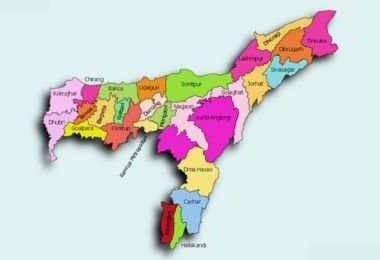
Why Assam is named as Assam?
The earliest name of Assam was ‘Pragjyotisha’ and its capital was ‘Pragjyotishpur’. The word ‘Pragjorishpura’ means ‘Eastern Light.’ Later, the region became known as ‘Kamrup’ later during the Puranic times after the name of Hindu God of Love – Kamdeva. Some attribute the origin of the word Assam to the Ahom dynasty, who ruled the state for nearly 600 years, while some believe that its ‘uneven’ (asam means uneven) topography, comprising hills and plains, gave it the name Assam.
demography of assam
Assam’s human landscape is diverse as its physiography. It has been the meeting ground of diverse ethnic and cultural streams. People from various traits, including Austro-Asiatics, Dravidians, Tibeto-Burmans, Mongoloids and Aryans have all made Assam their home, enriching the people of the state. The ethnic groups of Assam include Bodos, Dimasas, Karbi, Tai-Ahom, Mishing, Rabha, Deori, and Tiwa. The total population of Assam is 30.57 million, according to Census 2011.
Biodiversity of assam
Assam is dominated by the alluvial plains of the Brahmaputra and Barak, along with its tributaries. The Mikir Hills plateau (also known as Karbi Anglong Plateau), the North Cachar Hills and marginal plateau and hills from the adjoining states make up the highland. The Brahmaputra has over 120 tributaries and distributaries, making Assam’s Brahmaputra valley fertile. Along with its tributaries, it contributes to soil fertility and promotes agriculture, trade and cultural development of Assam, besides crafting its landscape. However, every year, floods, due to the Brahmaputra’s and its tributaries’ swelling, inflict damage to the state’s economy.
The river Barak originates at the Barail range south of Kohima at an altitude of 2,995 metres above the Mean Sea Level (MSL) and flows through South Assam mainly through Kachar, Hailakandi and Karimganj districts.
Assam has as many as 51 forest types and sub-types and the species’ diversity is spectacular. Hollong (Dipterocarpusmacrocarpus), the tallest tree of Assam and also the state tree, is the most predominant constituent of these forests. The associated species are borpat, jutuli, sam, dewa sam, nahar, teeta chap, bhelu, mekai, etc. In Assam, as many as 293 species of orchids are reported. The kopou (Foxtail orchid) is the state flower. The recently established Kaziranga National Orchid and Biodiversity Park boasts of more than 500 of the estimated 1,314 orchid species found in India.
wildlife of assam
Kaziranga is home to the endangered Indian one-horned rhinoceros, the state animal of Assam. The state is also a habitat for numerous other endangered and threatened species, including the white-winged wood duck or deohanh, the state bird, Bengal florican, black-breasted parrotbill, Bengal tiger, Asian elephant, pygmy hog, wild water buffalo, Indian hog deer, golden langur, Ganges river dolphin, and many others. The state has the largest population of wild water buffalo in the world. In addition to the above, there are other national parks in Assam, namely Dibru Saikhowa National Park, Nameri National Park, Orang National Park and Pabitora, Marat Longri and Dihing-Patkai wildlife sanctuaries. Assam also has many important bird sanctuaries. The best known being the Deeporbeel Bird Sanctuary, a Ramsar Site under Guwahati’s municipal limits.
state animal, bird, tree & flower
State Symbols
Assam takes pride in its rich biodiversity, exemplified by its unique selection of state symbols. The one-horned rhinoceros has been designated as the state animal, symbolizing the state’s commitment to wildlife conservation. The graceful white-winged wood duck, known locally as ‘deo-hah’ serves as the state bird. The hollong (scientific name – Dipterocarpus retusus), chosen as the state tree of Assam, stands tall as a symbol of strength and endurance. Adding to the floral beauty, the state flower is the exquisite foxtail orchid.
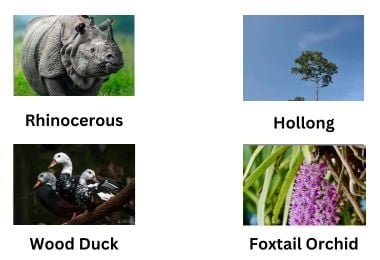
Assam: a brief history
From the fourth century A.D., we have a much clearer picture of the history of Assam with the help of available sources. Yuan Chwang’s (also spelt as Hiuen Tsang) travel accounts reveal that Pusyavarman of the Varman Dynasty ruled Kamrup during that period. He was followed by other kings till the seventh century when Bhaskaravarman (the contemporary of Harshavardhan) came to rule as the last king. After the Varmans, three other dynasties ruled Kamrup, beginning with Salastambha, followed by the Palas and then, the Khens. It was during the rule of the Khens that the Mughals first invaded Assam. After the fall of the Khans, the Koches rose to power in 1515 A.D. By that time, the Ahoms were also expanding their rule from the east. The Sutiyas were ruling in the extreme north-east, the Kacharis in mid-Assam and in between them a number of chieftains called ‘Bhuyans’ were exercising hold over the Brahmaputra plains.
assam during the reign of the ahoms
The Ahoms subjugated almost all of them and consolidated the entire valley into one empire, which they ruled for almost 600 years. They became an integral and dominant force in the history of Assam. An offshoot of the Tais or Shans of Southeast Asia, the Ahoms had their roots in Thailand. They migrated to the Brahmaputra valley and gave shape to the population of Assam of today. The Ahoms kings, subsequently, ruled the land till the province was annexed to British India in 1826 with the signing of the Treaty of Yandaboo. However, prior to the British invasion, the Mughals invaded and occupied the Ahom capital Gargaon in 1662, forcing the king, Swargadeo Jayadhwaja Singha, to flee to the hills. Subsequently, came the most towering personality of Assam history in the form of Lachit Barphukan, an Army General. Lachit set out for Guwahati in August 1667, and by November that year, ousted the Mughals from the last Ahom frontier—Manas. In January 1668, Aurangzeb again dispatched a large army under Raja Ram Singh’s command to reoccupy Assam. Raja Ram Singh, encouraged by his initial success, launched a massive naval assault. The Battle of Saraighat was thus, fought in 1671 between the Mughal Empire (led by Kachwaha king Raja Ram Singh I) and the Ahom kingdom (led by Lachit Borphukan) on the Brahmaputra river at Saraighat, now in Guwahati. The battle lasted one full day and Lachit could not be thwarted this time. The huge Mughal army succumbed to defeat against a small contingent led by Lachit Barphukan.
assam during the british period
In 1816, the Burmese troops attacked Assam and then, again in 1819. For a very brief period, they virtually ruled the entire Assam from 1819 to 1824. A reign of terror was unleashed by the Burmese on the people of Assam, who fled to neighbouring kingdoms and British-ruled Bengal. The war concluded after signing of the Treaty of Yandaboo in 1826 between the Burmese and the British, with the British taking control of Western Assam. Purandar Singha was made the king of Upper Assam by the British in 1833, the arrangement lasted till 1838. Thereafter, the British gradually annexed the entire region.
Decades later in 1906, Assam was made part of Eastern Bengal and Assam province. This was, however, revoked in 1911. In 1913, the first Legislative Council of Assam was formed, which transformed into the Assam Legislative Assembly in 1937 at Shillong, the erstwhile capital of Assam. With the partition of India in 1947, Assam became a constituent state of India. The district of Sylhet in Assam (excluding Karimganj sub-division) was given to East Pakistan (which later became Bangladesh) with the Sylhet Referendum held in 1946. These two arrangements caused large-scale migration into Assam.
Assam during independence movement
Assam’s contribution to the freedom struggle was evident from the days of Sepoy Mutiny of 1857. Maniram Dewan, the first Assamese tea planter was interested in establishing private tea plantations in Assam. Due to the opposition faced from the British in establishing private tea plantations, he became hostile to the British and revolted by opposing their policies. When the Indian sepoys started an uprising against the British, he could see an opportunity, and together with other activists like Piyali Baruah, he conspired against the British. Unfortunately, their conspiracy came to light and he along with other leaders was arrested. Maniram Dewan and Piyali Baruah were publicly hanged by the British for conspiring against them during the 1857 Sepoy Mutiny. Their death was widely mourned in Assam and resulted in an open uprising, which was suppressed brutally. At the turn of the century (1920), Assam joined the freedom movement led by Mahatma Gandhi. Assamese patriots like Tarun Ram Phukan, Nabin Chandra Bordoloi, Hem Baruah and others joined the National struggle for Independence. Even in the 1942 Quit India Movement, a number of martyrs laid down their lives, of which special mention may be made of Kanaklata, a teenaged girl who died in police firing while trying to hoist the National Flag at the police station of Gohpur. Kushal Konwar, another young freedom fighter, was falsely implicated in a train derailment case by the Britishers and was executed. Besides these, other incidents like destruction of a military air strip at Sorbhog by local villagers took place. In this way, people of different ethnic groups residing in Assam jointly participated in the freedom struggle. After Independence, Gopinath Bordoloi was elected the first Chief Minister of Assam.
festivals and dances
The Assamese culture is a rich and exotic drapery of many races that evolved through a long assimilative process. Bihu is the most popular festival and represents the essence of Assam. It denotes a set of three different festivals of all people irrespective of caste, creed, religion, faith and belief. The word Bihu is derived from the language of the Dimasa Kacharis, who have been agrarian since time immemorial. Their supreme god is ‘Brai Shibrai’. The first produce of the season is offered to ‘Brai Shibrai’ while wishing for peace and prosperity. ‘Bi’ means ‘to ask’ and ‘Shu’ means ‘peace and prosperity’ in the world. Hence, the word ‘Bishu’ gradually became ‘Bihu’ to accommodate linguistic preferences. ‘Rongali Bihu’ marks the advent of spring and the first day of the Hindu solar calendar. The first day of ‘Rongali Bihu’ is called ‘Gorubihu’, where the cows are worshipped. Rongali Bihu is celebrated with great pomp and grandeur and the famous mesmerising Bihu dance, on the beat of drums and flutes enthralls everyone. This joyous dance is performed by both young men and women and is characterised by brisk dance steps, and rapid hand and hip movement. Another dance form during the Bihu is ‘Husori’. It is a kind of carol sung by a group of young men and women. The Husori party visits houses from one end of the village to the other, singing Husori songs with religious themes on the beat of drums, cymbals and a bamboo instrument called ‘toka’. Bihu dancers wear traditional colourful Assamese clothing, the women wear mekhela-sador, riha and the men wear dhoti and kurta made of muga silk. The traditional dance of the Bodos is Bagurumba. There are no specific days and times to perform this dance. In Kherai puja of the Bodos, in which they worship Bathou or Shiva, a girl must perform the religious dance in front of the altar. Likewise in the ‘Deodhani’ dance, a girl dances on the beat of the kham (drum) and siphung (flute), propitiating many deities from Shiva to Lakshmi. The ‘Dimasa’ dance form is called ‘Baidima’. ‘Bishu’ is an important festival celebrated by Dimasa. Tiwas in Dimoria have a traditional Bihu dance called ‘Lalilang’. Among festivals of Karbi tribe, ‘Rongker’ is one festival held around January-February, in which the entire village participates thanking various gods for the prosperity and well-being of the community. The ‘Chomkan’ (also known as thi-karhi and Chomangkan) is a festival unique to the Karbis. ‘Sangken’ is the main festival of Khamtis. The main festival of Mishing people is ‘Ali-Ayé-Ligang’. It is a spring festival associated with agriculture, especially with the beginning of the Ahu paddy cultivation. It is celebrated by the Mishing ethnic community. The festival marks the onset of the sowing season. ‘Me-Dam-Me-Phi’ is one of the important festivals observed by the Ahoms from ancient times. It is celebrated by the Ahom people on 31 January every year in memory of the departed. It is the manifestation of the concept of ancestor worship that the Ahoms share with other people originating from the Tai-Shan stock.
tourist places of assam
Assam has a profusion of national parks, sanctuaries and wetlands, besides reserved forests that house some of India’s most endangered animals and birds. It is home to two of India’s five world heritage sites—Kaziranga in central Assam and Manas close to the Bhutan border.
KAMAKHYA TEMPLE
Kamakhya Temple is one of the most venerated Shakti shrines in India, associated with the legend of Shiva and Daksha Yagna. Located on Neelachal hill or Kamagiri, it is the abode of goddess Kamakhya, and a prime centre of tantric practices in the country. The temple was constructed in 1562 A.D. at the behest of Koch king Naranarayan. Lakhs of people from all over the country come to the shrine throughout the year to offer prayers. The most important annual festival here is Ambubachi, which is held every year in the month of Ashada (June).
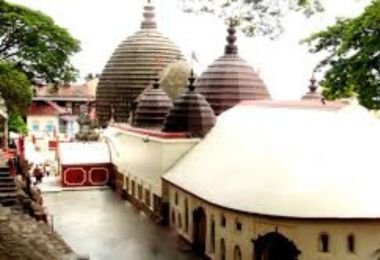
MAJULI ISLAND
The Brahmaputra has crafted and cradled Majuli, the world’s largest inhabited river island and the seat of Vaishnavism in Assam. It is situated 200 km east of Guwahati. Local people still speak Brajabali, the ancient tongue of Mathura in Uttar Pradesh, suggesting cultural linkages between the two places. Majuli has 23 villages with a density of 300 individuals per square kilometre. A majority of the inhabitants are Mishing, a tribe that migrated from Arunachal Pradesh centuries ago. The Deori and Sonowal Kachari tribes too have a sizeable presence, as do the Assamese-speaking non-tribal people. For the islanders, the only mode of communication is a ferry service. Majuli has been the seat of Assamese civilisation since Sankardeva, the sixteenth century Vaishnavite saint, who established Sattras (monasteries) on it. Pottery made by the women of Majuli is famous for its striking similarity with the Harappan pottery. This
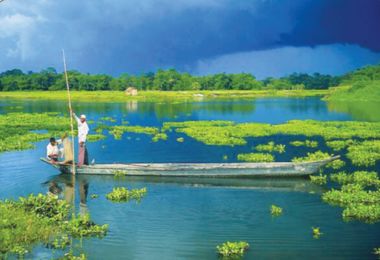
Poa Mecca
Poa Mecca, meaning ‘a quarter of Mecca’, is a place of pilgrimage for Muslims in Assam. It is located at Hajo, near Guwahati. According to legends, an Iraqi prince-turnedpreacher, Ghiyasuddin Auliya, is said to have brought a lump of earth from Mecca and enshrined the same at a spot here in the twelfth century A.D. Subsequently, the mosque was built by Sujauddin Mohammed Shah in 1657 A.D. It is held by the Muslims that by offering prayer at this mosque one gains one-fourth spiritual enlightenment of what could be gained by praying at Mecca.
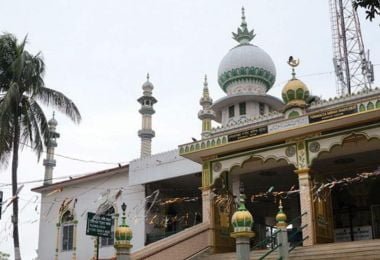
Rang Ghar
‘Rang Ghar’ or the Royal Pavilion was first built by Swargadeo (Heavenly King) Rudra Singha (1696-1714) and later developed by his heir Pramatta Singha in 1744 at Rupahipathar in Sivasagar. Rang Ghar’s northern and western sides are longer, each with three large and two small openings. The building has two storeys, each divided internally into one large central room flanked by two smaller ones at the eastern and western end. Earthen mounds surrounded the Rang Ghar where the people used to sit. Rudra Singha formalised the events of sports as were prevalent during the time. The king, his queen and his officials used to enjoy the games and sports from the upper storey of the Rang Ghar, while the common people enjoyed sitting on the earthen mounds.
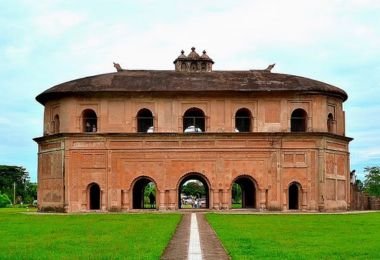
Kareng Ghar
‘Kareng Ghar’ is one of the most striking examples of the Ahom architecture. It is located in a place called Gargaon, Sivasagar, in Assam. The palace structures are made of wood and stones. From east to west, several rooms run along a long corridor, and from north to south are smaller wings.The ground floor served as stables, storerooms and servant quarters. The royal apartments were on the upper storey, of which only a few rooms now remain. There are stairs leading
to the terrace. The earliest constructions were during
the time of Swargadeo Rudra Singha in 1698 A.D. After his death, the Kareng Ghar, which together with the underground Talatal Ghar constitutes the Rangpur Palace, went through many architectural alterations.

